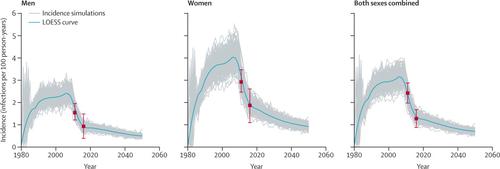The Lancet HIV ( IF 16.1 ) Pub Date : 2020-02-13 , DOI: 10.1016/s2352-3018(19)30436-9 Adam Akullian 1 , Michelle Morrison 2 , Geoffrey P Garnett 2 , Zandile Mnisi 3 , Nomthandazo Lukhele 4 , Daniel Bridenbecker 5 , Anna Bershteyn 6

|
Background
The rapid scale-up of antiretroviral therapy (ART) towards the UNAIDS 90-90-90 goals over the last decade has sparked considerable debate as to whether universal test and treat can end the HIV-1 epidemic in sub-Saharan Africa. We aimed to develop a network transmission model, calibrated to capture age-specific and sex-specific gaps in the scale-up of ART, to estimate the historical and future effect of attaining and surpassing the UNAIDS 90-90-90 treatment targets on HIV-1 incidence and mortality, and to assess whether these interventions will be enough to achieve epidemic control (incidence of 1 infection per 1000 person-years) by 2030.
Methods
We used eSwatini (formerly Swaziland) as a case study to develop our model. We used data on HIV prevalence by 5-year age bins, sex, and year from the 2007 Swaziland Demographic Health Survey (SDHS), the 2011 Swaziland HIV Incidence Measurement Survey, and the 2016 Swaziland Population Health Impact Assessment (PHIA) survey. We estimated the point prevalence of ART coverage among all HIV-infected individuals by age, sex, and year. Age-specific data on the prevalence of male circumcision from the SDHS and PHIA surveys were used as model inputs for traditional male circumcision and scale-up of voluntary medical male circumcision (VMMC). We calibrated our model using publicly available data on demographics; HIV prevalence by 5-year age bins, sex, and year; and ART coverage by age, sex, and year. We modelled the effects of five scenarios (historical scale-up of ART and VMMC [status quo], no ART or VMMC, no ART, age-targeted 90-90-90, and 100% ART initiation) to quantify the contribution of ART scale-up to declines in HIV incidence and mortality in individuals aged 15–49 by 2016, 2030, and 2050.
Findings
Between 2010 and 2016, status-quo ART scale-up among adults (aged 15–49 years) in eSwatini (from 34·0% in 2010 to 74·1% in 2016) reduced HIV incidence by 43·57% (95% credible interval 39·71 to 46·36) and HIV mortality by 56·17% (54·06 to 58·92) among individuals aged 15–49 years, with larger reductions in incidence among men and mortality among women. Holding 2016 ART coverage levels by age and sex into the future, by 2030 adult HIV incidence would fall to 1·09 (0·87 to 1·29) per 100 person-years, 1·42 (1·13 to 1·71) per 100 person-years among women and 0·79 (0·63 to 0·94) per 100 person-years among men. Achieving the 90-90-90 targets evenly by age and sex would further reduce incidence beyond status-quo ART, primarily among individuals aged 15–24 years (an additional 17·37% [7·33 to 26·12] reduction between 2016 and 2030), with only modest additional incidence reductions in adults aged 35–49 years (1·99% [–5·09 to 7·74]). Achieving 100% ART initiation among all people living with HIV within an average of 6 months from infection—an upper bound of plausible treatment effect—would reduce adult HIV incidence to 0·73 infections (0·55 to 0·92) per 100 person-years by 2030 and 0·46 (0·33 to 0·59) per 100 person-years by 2050.
Interpretation
Scale-up of ART over the last decade has already contributed to substantial reductions in HIV-1 incidence and mortality in eSwatini. Focused ART targeting would further reduce incidence, especially in younger individuals, but even the most aggressive treatment campaigns would be insufficient to end the epidemic in high-burden settings without a renewed focus on expanding preventive measures.
Funding
Global Good Fund and the Bill & Melinda Gates Foundation.
中文翻译:

90-90-90对eSwatini中HIV-1发生率和死亡率的影响:数学模型研究。
背景
在过去十年中,针对联合国艾滋病规划署90-90-90目标的抗逆转录病毒疗法(ART)的快速推广,引发了关于通用测试和治疗是否可以结束撒哈拉以南非洲地区HIV-1流行的争论。我们旨在开发一种网络传播模型,该模型经过校准以捕捉ART扩大中特定年龄和特定性别的差距,以评估达到和超越UNAIDS 90-90-90治疗目标的艾滋病毒的历史和未来影响-1发病率和死亡率,并评估这些干预措施是否足以在2030年之前实现流行病控制(每1000人年1次感染的发生)。
方法
我们以eSwatini(前身为斯威士兰)为案例研究来开发我们的模型。我们使用了2007年斯威士兰人口健康调查(SDHS),2011年斯威士兰HIV发病率测量调查以及2016年斯威士兰人口健康影响评估(PHIA)调查中按5岁年龄段,性别和年份划分的HIV流行率数据。我们按年龄,性别和年份估算了所有HIV感染者中ART覆盖率的普遍程度。来自SDHS和PHIA调查的特定年龄男性包皮环切率数据被用作传统男性包皮环切和自愿医疗男性包皮环切术(VMMC)扩大规模的模型输入。我们使用可公开获得的人口统计数据对模型进行了校准;按5岁年龄段,性别和年份划分的HIV流行率;以及按年龄,性别和年份划分的ART覆盖率。
发现
在2010年至2016年之间,eSwatini成年人(15-49岁)的现状抗逆转录病毒治疗规模不断扩大(从2010年的34·0%降至2016年的74·1%),艾滋病毒感染率降低了43·57%(95%)可信区间为39·71至46·36),艾滋病毒死亡率在15-49岁的人群中下降了56·17%(54·06至58·92),男性发病率和女性死亡率的下降幅度更大。假设按年龄和性别划分的2016年ART覆盖率水平,到2030年成人艾滋病毒发病率将下降至每100人年1·09(0·87至1·29),1·42(1·13至1·71) ),女性每百人年)和男性每百人年0·79(0·63至0·94)。按年龄和性别均匀地达到90-90-90的目标将进一步降低除现状抗病毒治疗之外的发病率,主要是在15至24岁的人群中(2016年之间还会减少17·37%[7·33至26·12]和2030年),在35-49岁的成年人中,发病率仅略有下降(1·99%[–5·09至7·74])。在感染后平均6个月内在所有艾滋病毒感染者中实现100%的抗病毒治疗-合理的治疗效果上限-将使每100人的成人艾滋病毒感染率降至0·73感染(0·55至0·92) -到2030年的年数,以及到2050年的每100人年的0·46(0·33至0·59)。
解释
过去十年来,ART的大规模推广已经大大降低了eSwatini中HIV-1的发病率和死亡率。聚焦于抗逆转录病毒疗法将进一步降低发病率,尤其是在年轻个体中,但是即使是最积极的治疗运动也无法在高负担的环境中结束这一流行病,而无需重新关注扩大预防措施。
资金
全球优质基金和比尔及梅琳达·盖茨基金会。



























 京公网安备 11010802027423号
京公网安备 11010802027423号